1. Introduction
The NTT Group maintains in-house technical requirements (NTT-TRs) that set out the electromagnetic compatibility (EMC) quality levels to be adhered to when developing or procuring telecommunication equipment and devices. NTT-TRs stipulate EMC requirements (acceptable limits and measurement methods) to ensure safe and secure telecommunication services in terms of emissions (of electromagnetic disturbances), immunity (to electromagnetic disturbances), and overvoltage tolerance capability (Fig. 1).

Fig. 1. NTT-TRs for EMC standards.
The acceptable EMC limits and measurement methods specified in NTT-TRs conform to international standards for information technology equipment (ITE) or telecommunication equipment set out by organizations such as IEC/CISPR (see section 2) and ITU-T SG5 (International Telecommunication Union, Telecommunication Standardization Sector, Study Group 5) so that enterprises in related industrial sectors in Japan and abroad can abide by the NTT-TRs.
2. Summary of CISPR Seoul Meeting
The Comité International Spécial des Perturbations Radioélectriques (CISPR)―also known as the International Special Committee on Radio Interference―is a special committee of the International Electrotechnical Commission (IEC). To ensure that there are consistent global standards, it issues international standards for the emission levels of unwanted electromagnetic disturbances from various devices (radio interference sources) as well as for the apparatus and methods used to measure such disturbances. The CISPR secretariat is located in Geneva, Switzerland.
The 2011 IEC/CISPR Plenary Meeting was held at the Palace Hotel in Seoul from October 11 to 21. The Steering Committee, the five subcommittees (Subcommittees A, B, F, H, and I), 14 Working Groups, and the IEC Subcommittee SC77C (High power transient phenomena) met in parallel with the Plenary Meeting. Japan sent 35 delegates representing the Ministry of Internal Affairs and Communications, the National Institute of Information and Communications Technology, NTT, universities, testing organizations, and industry groups (Photos 1 and 2). An organizational map of the EMC-related IEC committees is shown in Fig. 2.

Photo 1. Meeting place: the Palace Hotel in Seoul.
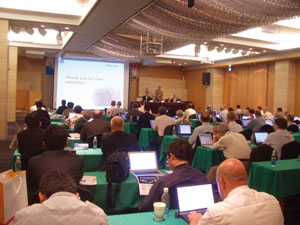
Photo 2. Meeting.

Fig. 2. EMC-related IEC committees (organizational maps of TC 77 and CISPR).
3. Main topics at IEC/CISPR Seoul Meeting
3.1 Smart grid standardization activities (creation of a WG)
Smart grids have been attracting increasing attention in recent years as a means of preserving the global environment and mitigating risks from major natural disasters. They provide coordinated systematic control over loads on decentralized energy sources, such as storage batteries and natural energy sources, to shift peak loads and reduce overall power consumption. To examine smart grids, the IEC decided to establish a Strategic Group on Smart Grid (SG3) at the Sao Paulo meeting in November 2008 and selected a convenor and 13 members at the February 2009 Seoul meeting. SG3 released a standardization roadmap in June 2010 and noted the need to work with TC77 and CISPR in the area of EMC.
In view of this background, it was agreed at the recent Seoul meeting to establish a smart grid WG under the CISPR Steering Committee. It was also decided to circulate a Document for Comments (DC) in November 2011 to the National Committees (NCs), SCs, and Technical Committees (TCs), such as TC77, with strong relations with CISPR to nominate members for the new WG. It was determined that the WG will report on the progress of its activities to the Steering Committee, which meets by conference call every two months.
3.2 Proposal to establish new acceptable limits and measurement methods for radiated emissions below 30 MHz
This proposal, tabled by Germany, was triggered by field data indicating that large-screen plasma TVs produced radiated emissions below 30 MHz and that these emissions were interfering with radio services. Current CISPR standards for measurement methods and acceptable limits for sub-30-MHz radiated emissions apply only to special devices, such as induction heating devices. This new proposal, therefore, called for these regulations to be extended to cover all devices. As a majority was in general agreement with the need for measurements, it was decided that, as a first step, Subcommittee A would start to examine antenna calibration methods, test site validation methods, and other issues in line with Japan's approach to the problem.
3.3 Proposal to establish new EMC provisions for conducted emissions between 9 kHz and 150 kHz
This proposal, tabled by Australia, recommends that acceptable levels of conducted emissions be examined in the range from 9 kHz to 150 kHz, which is not covered in current CISPR standards, in light of the introduction of smart meters using low-speed power line communications (PLC) with frequencies up to 450 kHz. In response to a questionnaire on the need to regulate such acceptable levels (CISPR/S/337/INF), Japan submitted the comment that there should be discussion about introducing emission measurements on the way to creating a standard since there have been cases of PLC impairing the performance of other devices and causing malfunctions. Countries submitted opinions both in agreement and opposition, but it was pointed out that there were procedural problems in how the questionnaire was circulated. Therefore, it was decided to resubmit the questionnaire to NCs and obtain comments. It was agreed that an action plan draft based on the obtained comments would be presented prior to the 2012 Plenary Meeting.
4. Main issues and discussions
The NTT Group's in-house EMC regulations include EMC standards for telecommunication equipment (in-house standards), which specify the minimum EMC requirements and operational methods for telecommunication equipment that NTT uses to provide telecommunication services as well as for telecommunication equipment provided to customers. NTT-TRs consist of technical requirements taken from the in-house standards [2]. This section introduces the direction of discussions on standardization issues concerning these test methods, test apparatus, radiated emissions standards, and immunity standards.
4.1 Subcommittee A
CISPR Subcommittee A is engaged in forming base international standards for radio disturbance measurement apparatus and methods. Its main mission is preparing and revising the CISPR 16 series of standards that specify radio disturbance measurement apparatus and methods and are designated as base standards cited by all other CISPR standards.
(1) Proposal of a simple alternative method using coupling decoupling networks (CDNE method)
The proposal (measurement apparatus specifications, measurement methods, and uncertainties) on the coupling decoupling network for emission measurement (CDNE method) will move to a Committee Draft for Vote (CDV). Japan has expressed reservations about the basic correlation between the CDNE method and the ten-meter method, but it did not oppose the establishment of the CDNE method as a disturbance measurement method. Japan did submit technical comments on such matters as the CDNE specification and the rationale for the testing setup.
The CDNE method, as a measurement method, was originally intended for lighting equipment tests and does not require radiated disturbance measurements (between 30 MHz and 300 MHz) at 10 m (Fig. 3). Japan had been seeking an accurate specification for the CDNE method, because its inclusion in the CISPR 16 series, the base standards for measurement apparatus, raised the possibility of its use in tests of devices other than lighting equipment.

Fig. 3. CDNE test setup (measures power-supply line radiated disturbances between 30 MHz and 300 MHz).
At the Seoul meeting, Japan was successful in getting incorporated into the text the importance of longitudinal conversion loss provisions for CDNE in tests of products dominated by differential-mode components and the issue [3], [4] of common-mode crosstalk.
Japan's proposal was based mainly on the results of actual measurements performed in NTT's R&D laboratories, which have a wealth of experience and a long track record with conducted disturbance measurements on transmission lines. Because of this factual basis, neutral third-party countries approved Japan's suggestions.
(2) Validation of test sites for measurements of radiated disturbances below 30 MHz
With the growing momentum of the energy-conservation movement in recent years, inverters and other energy-saving electrical products have been adopted in increasing numbers and are now in widespread use. However, there are concerns that these devices will lead to greater electromagnetic interference at frequencies below 30 MHz. To date, disturbances in the sub-30-MHz frequency range for most products have been regulated by the disturbance voltage at the power supply terminals. But as the development and transformation of electrical and electronic devices have changed disturbance-emission mechanisms, there is a growing need to directly measure and regulate radiated disturbances to avoid electromagnetic interference. Consequently, there is a growing need for measurement methods and standards for sub-30-MHz radiated disturbance measurements.
SC-A/WG1 set up new ad hoc groups for "test site validation" and "measurement methods" with respect to sub-30-MHz radiated disturbance measurements. Dr. Akira Sugiura from Japan (NICT) was selected as the convenor of the test site validation ad hoc group. It was also decided to circulate a DC (CISPR/A/978/DC) after the Seoul meeting and ask for volunteers from countries for the following tasks related to sub-30-MHz radiated disturbance measurements.
1. Loop antenna calibration methods (A/WG1)
2. Standards on test sites for radiated disturbances below 30 MHz (A/WG1)
3. Test site validation methods (A/WG1)
4. Standards for measurements of radiated disturbances below 30 MHz (A/WG2)
5. Uncertainties assessment of radiated disturbances below 30 MHz (A/WG2)
4.2 Subcommittee I
Subcommittee I is involved in creating international standards regarding EMC of ITE and multimedia devices. This subcommittee is preparing emissions standards (CISPR 13, 22, and 32) and immunity standards (CISPR 20, 24, and 35) for telecommunication equipment. It is working on two issues that have a direct bearing on NTT's business.
(1) Emission and immunity standards for multimedia equipment
This issue concerns the establishment of emission standards (CISPR 32) and immunity standards (CISPR 35) that target ITE and broadcast receivers. Since the functional barrier between them has disappeared, new standards that cover both categories are being drawn up. NTT's emissions TR and immunity TR are based on the existing CISPR 22 and CISPR 24 standards, but these TRs are expected to be replaced once CISPR 32 and CISPR 35 come into effect. The establishment of new standards that will govern NTT's required EMC performance in the future is therefore a highly relevant issue for NTT's business.
A vote was held on the Final Draft International Standard (FDIS) for CISPR 32 (the vote deadline was Dec. 9, 2011), and as a result the FDIS was approved. It was also decided to start debate quickly on the five pending Committee Drafts for Comments (CDs) with the aim of issuing them as an amendment 1 of CISPR 32 Edition 1.
Japan has steered the debate on this standard and has contributed multiple proposals. NTT has also contributed actively to the standardization process, particularly in the area of conducted disturbance measurement methods.
With respect to CISPR 35, the Seoul meeting concluded most of the debate on NC comments on the CD (I/380/CD) and it was agreed that the next step would be to prepare and vote on a CDV.
It was determined that the Subcommittee I WG4 management team will prepare the CDV draft based on the debate to date, confirm the CDV draft at the February 2012 WG4 meeting, and vote on it in time for the Subcommittee I meeting to be held in Bangkok in October 2012. The publication of this standard will speed up measurements and possibly have economic benefits, since where a device previously had to be measured under both CISPR 20 and CISPR 24, it can in future be measured under only CISPR 35.
(2) New ISN for measuring conducted disturbances at telecommunication ports
This issue involves the inclusion in CISPR standards of NTT's newly developed impedance stabilization network (ISN) for measuring conducted disturbances at telecommunication ports. This issue was also proposed at the 2010 Seattle meeting and this time it was accepted officially by Subcommittee I, which decided to propose the new type of ISN as a new measurement apparatus to Subcommittee A again.
A schematic diagram of the proposed ISN, which uses an asymmetrical transformer is shown in Fig. 4 and examples of the improvement in voltage-characteristic measurements of a transmission port when a telecommunication device's disturbance is measured with the proposed measurement apparatus are shown in Fig. 5 [5].
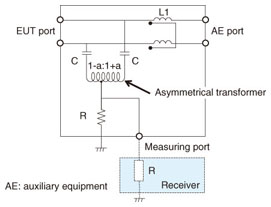
Fig. 4. Diagram of impedance stabilization network using an asymmetrical transformer.
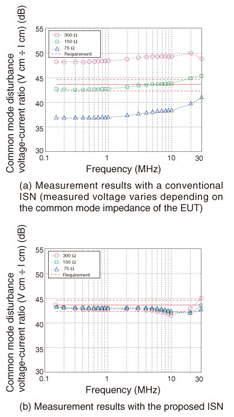
Fig. 5. Example of improved voltage characteristic measurements at telecommunication ports.
This example demonstrates that the proposed measurement apparatus can accurately measure common mode disturbance voltages independent of the common mode impedance of the device under test.
5. Concluding remarks
This article described the main topics discussed at the IEC/CISPR Seoul meeting and looked at the direction of those discussions. CISPR will continue to establish new standards and update existing standards to keep abreast of the many transformations in the electromagnetic environment, such as the convergence of telecommunication equipment and broadcasting equipment driven by broadband-service proliferation and the development of smart grids caused by the move to intelligent power control.
Through participation in international EMC standardization processes and active promotion of in-house regulations, the NTT Group is committed to maintaining a good electromagnetic environment and providing high-quality, highly reliable telecommunication services.
References
| [1] | NTT International Procurement website.
http://www.ntt.co.jp/ontime/eg/tr/tr.html |
|---|
| [2] | K. Tajima, Y. Akiyama, and F. Amemiya, "Standardization Activities in IEC/CISPR for Communications Electromagnetic Compatibility (EMC)," NTT Technical Review, Vol. 8, No. 2, 2010.
https://www.ntt-review.jp/archive/ntttechnical.php?contents=ntr201002gls.html |
|---|
| [3] | CISPR/A/WG1 (Seoul/Amemiya, Tajima, Hirasawa, Akiyama) 11-01,Oct. 2011.
|
|---|
| [4] | CISPR/A/WG2 (Seoul/Amemiya, Tajima) 11-01,Oct. 2011. |
|---|
| [5] | CISPR/I/WG3 (Hirasawa, Amemiya, Akiyama) 11-01,Oct. 2011.
|
|---|
 |
- Kimihiro Tajima
- Executive Manager, Development Promotion Project, NTT Energy and Environment Systems Laboratories.
He received the B.E. and M.E. degrees from the Department of Electronics at Kumamoto University in 1986 and 1989, respectively. He joined NTT Telecommunications Networks Laboratories in 1989. He has been engaged in studies on optical-scheme-based measuring methods in the EMC field and the development of mobile communication systems using infrared rays for EMC. He is the secretary of the Japanese National Committee of CISPR Group A. He is a member of the Institute of Electronics, Information and Communication Engineers (IEICE) and IEEE.
|
|---|
 |
- Yoshiharu Akiyama
- Senior Research Engineer, EMC Technology Group, Energy System Project, NTT Energy and Environment Systems Laboratories.
He received the B.E. and Dr.Eng. degrees in communication engineering from the University of Electro-Communications, Tokyo, in 1990 and 2010, respectively. Since joining NTT in 1990, he has been researching EMC of broadband communications such as wireless local area networks, DSLs, and PLT.
|
|---|
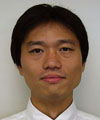 |
- Norihito Hirasawa
- Engineer, EMC Technology Group, NTT Energy and Environment Systems Laboratories.
He received the B.E. degree in electrical engineering from Tokyo University of Science, Chiba, in 1998. He joined NTT Electrical Communication Laboratory in 1998. He has been researching EMC of broadband communications such as PLT since 2008.
|
|---|
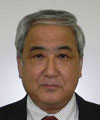 |
- Fujio Amemiya
- Senior Research Engineer, NTT Advanced Technology Corporation.
He received the B.E., M.E., and Dr.Eng. degrees in communication engineering from Tohoku University, Miyagi, in 1971, 1973, and 2007, respectively. He joined the Musashino Electrical Communication Laboratories, Nippon Telegraph and Telephone Public Corporation (now NTT) in 1973. He has been involved in the development of digital telephone sets and in the design, evaluation, and EMC testing of communication equipment.
|
|---|




















